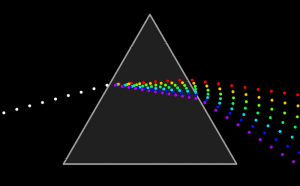range in working distance for which the image is (acceptably) focused.
DOF = Far Point – Near Point
see also Bokeh
range in working distance for which the image is (acceptably) focused.
DOF = Far Point – Near Point
see also Bokeh
Image side equivalent of the DOF (Depth Of Field), so it is the range of acceptable sharpness on image side, the range within which the Airy Disk stays within the COC (Circle Of Confusion).
The Diffraction limit describes the maximum possible MTF / resolution that a “perfect” lens could possibly have
(from latin dispergere, “to scatter”, to disperse” ) :
Dependency of a measure on frequency / wavelength.
 (C) Wikipedia, zum Animieren bitte klicken
(C) Wikipedia, zum Animieren bitte klicken
Using a Prism dispersion leads to splitting of white light beam into individual colors. A rainbow where light takes different paths inside the water dropplets, depending on their wavelength is another “real world” example of dispersion.
Every optical medium / glass type has different refraction indices for the various wavelength of light. The number that describes how different the light paths of the various wavelengths are, is the Abbe-number.
UNder dispersion formulas you find the most common formulas
Each optical material (glasses, plastics, gases) have a different refraction index for each wavelength.
Instead of keeping long tables, it’s possible to describe the behaviour of optical materials by formulas.
here are the main formulas used :
1: Sellmeier (preferred)

2: Sellmeier-2

3: Polynomial
![]()
4: RefractiveIndex.info
![]()
5: Cauchy
![]()
6: Gases
![]()
7: Herzberger
![]()
8: Retro
![]()
9: Exotic
![]()
see
Optical Distortion
TV Distortion
Optical Distortion vs. TV Distortion
Barrel Distortion
Pincushion Distortion
Synopsys command Lens DraWinG